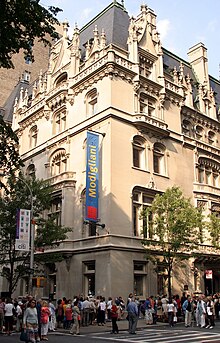Jewish Museum (New York)

The Jewish Museum on Fifth Avenue
|
|
| Established | 1904 |
|---|---|
| Location | 1109 5th Avenue at 92nd Street, Manhattan, New York |
| Coordinates | 40°47′07″N 73°57′27″W / 40.7854°N 73.9575°W |
| Type | Art Museum |
| Architect | C.P.H. Gilbert |
| Public transit access |
Bus: M1, M2, M3, M4, M86 Subway: 86 St |
| Website | Official website |
The Jewish Museum is an art museum and repository of cultural artifacts, housed at 1109 Fifth Avenue, in the former Felix M. Warburg House, along the Museum Mile in the Upper East Side of Manhattan, New York City. The first Jewish museum in the United States, as well as the oldest existing Jewish museum in the world, it contains the largest collection of art and Jewish culture excluding Israeli museums, more than 30,000 objects. While its collection was established in 1904 at the Jewish Theological Seminary of America, the museum did not open to the public until 1947 when Felix Warburg's widow sold the property to the Seminary. It focuses both on artifacts of Jewish history and on modern and contemporary art. Its permanent exhibition, Culture and Continuity: The Jewish Journey, is supplemented by multiple temporary exhibitions each year.
Felix M. Warburg and his brother Paul Warburg were international bankers in the early 20th Century who cultivated their fortunes at the New York banking firm Kuhn, Loeb, & Co. Felix and Paul moved to the United States in 1894 and Felix soon after married Freida Schiff, daughter of Jacob Schiff, a partner at the firm. Active in the Jewish community and philanthropy for most of his life, Felix organized the Federation of Jewish Philanthropies by combining 75 separate charities and organizations. He also served as the director of the Jewish Theological Seminary of America along with his father-in-law Jacob H. Schiff. By that time, the Warburg family had been living in the house since 1908 when construction that began two years prior was completed.
The collection that seeded the museum began with a gift of 26 Jewish ceremonial art objects from Judge Mayer Sulzberger to the Jewish Theological Seminary of America on January 20, 1904, where it was housed in the seminary's library. The collection was moved in 1931, with the Seminary, to 122nd and Broadway. The Jewish Theological Seminary received over 400 Jewish ceremonial items and created, 'The Museum of Jewish Ceremonial Objects', previously the Jacob Schiff Library. The collection was subsequently expanded by major donations from Hadji Ephraim Benguiat and Harry G. Friedman. In 1939, in light of WWII, Poland sent about 350 objects to New York city from homes and synagogues in order to preserve them.
...
Wikipedia

